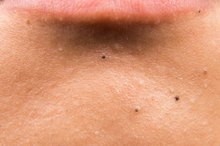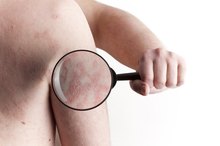What does fact checked mean?
At Healthfully, we strive to deliver objective content that is accurate and up-to-date. Our team periodically reviews articles in order to ensure content quality. The sources cited below consist of evidence from peer-reviewed journals, prominent medical organizations, academic associations, and government data.
- MedlinePlus: Skin; abnormally dark or light
- National Center for Biotechnology Information: Postinflammatory hyperpigmentation
- National Center for Biotechnology Information: Postinflammatory hyperpigmentation
The information contained on this site is for informational purposes only, and should not be used as a substitute for the advice of a professional health care provider. Please check with the appropriate physician regarding health questions and concerns. Although we strive to deliver accurate and up-to-date information, no guarantee to that effect is made.
How to Get Rid of Dark Circles Around the Mouth
Having dark circles around your mouth can be unflattering. Dark circles are caused by hyperpigmentation or when you have more melanin in certain areas of the skin. Several factors can cause hyperpigmentation, like exposure to the sun, skin inflammation or endocrine diseases, according to MedlinePlus 1. Fortunately there are ways to lighten dark circles around your mouth and even out your complexion.
Exfoliate daily with a mild and gentle facial scrub to lift dead skin cells and help fade dark areas around the mouth. Apply a pea-size amount of the exfoliant to a damp washcloth. Gently rub the product on your face to remove pigmented skin cells and cleanse the skin.
How to Reduce Black Spots on the Face
Learn More
Use a skin brightening cream or serum to lighten dark areas. Pat a thin layer of a moisturizing skin treatment, containing Vitamin C, kojic acid or grapeseed extract, around your mouth. According to Whole Living Magazine, these ingredients help to block the enzyme tyrosinase, which your skin cells need to produce melanin. Follow the instructions carefully and don’t use these skin-lightening products for more than three weeks.
Lighten skin naturally with lemon juice. In a small bowl, mix the juice from 1/4 lemon with 1 tablespoon of yogurt or honey to dilute the mixture. Apply to dark areas and allow the mask to dry. Gently rinse the skin clean with warm water.
How to Get Rid of Psoriasis & Eczema
Learn More
Stay out of the sun, sun lamps and tanning beds. Exposing the skin to ultraviolet rays can cause skin damage and cause areas with more melanin to appear darker. Wear sunscreen while out to protect the skin and avoid overexposure, suggests MedlinePlus.
Use liquid foundation or concealer to cover up dark circles. To cover the darkened areas completely, choose makeup colors that match your skin tone exactly. Dab the makeup on dark areas with your fingertips to even out your skin tone.
Tips
By shedding dead facial skin with an exfoliant, you allow a skin brightener’s active ingredients to penetrate the skin completely.
Keep your skin clean. Focusing on cleaning the cheeks and forehead can cause you to neglect the skin around your mouth. Make sure to clean your entire face thoroughly.
Warnings
If dark circles persist, make an appointment to see your doctor to discuss possible causes of dark circles or for a prescription based treatment. Ask questions about any daily habits that may be contributing to the hyperpigmentation problem or the use of harsh skin care products.
Related Articles
References
- MedlinePlus: Skin; abnormally dark or light
- National Center for Biotechnology Information: Postinflammatory hyperpigmentation
- InStyle: Simple Beauty Solutions: How to Get Rid of Dark Spots
- Elle: Dermatologist Tips for Even Skin Tone
- Vashi NA, de Castro Maymone MB, Kundu RV. Aging differences in ethnic skin. J Clin Aesthet Dermatol. 2016;9(1):31-38.
- American Osteopathic College of Dermatology. Hyperpigmentation.
- Bandyopadhyay D. Topical treatment of melasma. Indian J Dermatol. 2009;54(4):303-309. doi:10.4103/0019-5154.57602
- Kang SJ, Choi BR, Lee EK, et al. Inhibitory effect of dried pomegranate concentration powder on melanogenesis in B16F10 melanoma cells; involvement of p38 and PKA signaling pathways. Int J Mol Sci. 2015;16(10):24219-42. doi:10.3390/ijms161024219
- Parveen R, Akhtar N, Mahmood T. Topical microemulsion containing Punica granatum extract: its control over skin erythema and melanin in healthy Asian subjects. Postepy Dermatol Alergol. 2014;31(6):351-5. doi:10.5114/pdia.2014.47117
- Kim E, Hwang K, Lee J, et al. Skin protective effect of epigallocatechin gallate. Int J Mol Sci. 2018;19(1). doi:10.3390/ijms19010173
- Kim YC, Choi SY, Park EY. Anti-melanogenic effects of black, green, and white tea extracts on immortalized melanocytes. J Vet Sci. 2015;16(2):135-43. doi:10.4142/jvs.2015.16.2.135
- Zhou BR, Ma LW, Liu J, et al. Corrigendum to "protective effects of soy oligopeptides in ultraviolet B-induced acute photodamage of human skin". Oxid Med Cell Longev. 2018;2018:3871280. doi:10.1155/2016/5846865
- Adhikari D, Panthi VK, Pangeni R, Kim HJ, Park JW. Preparation, characterization, and biological activities of topical anti-aging ingredients in a Citrus junos callus extract. Molecules. 2017;22(12). doi:10.3390/molecules22122198
Writer Bio
Nicole Hogan-Jenkins began writing professionally in 2010. She is a certified personal trainer, sports nutrition specialist, fitness business owner and competitive fitness athlete. Hogan holds a Bachelor of Arts in journalism from Indiana University.









